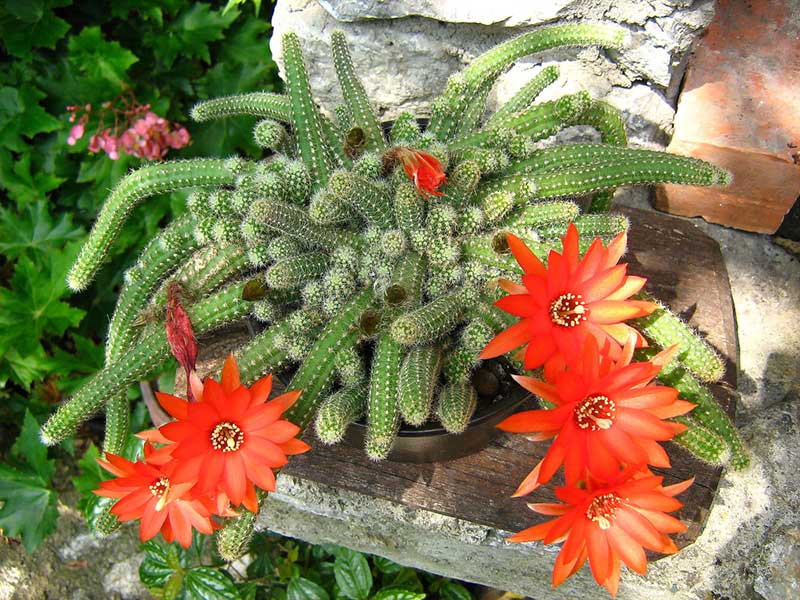
The peanut cactus (Echinopsis chamaecereus) produces a cluster of fuzzy, peanut-shaped stems giving it its common name. This cactus is prized for its stunning 2-inch blooms in brilliant shades of orange-red. Blooms typically cover the plant with several flushes of blooms beginning in spring and lasting into the summer. This cactus if hardy in USDA plant hardiness zones 10a to 11b, but can be grown inside as a houseplant in cooler regions.
Light and Temperature Requirements
The peanut cactus can be grown as a perennial in USDA plant hardiness zones 10 and 11, but it must be overwintered inside in cooler regions. It prefers full sun for at least 6 to 8 hours a day, but will benefit from some afternoon shade in hot, dry regions like Arizona.
When grown as a houseplant the peanut cactus needs as much light as it can get, particularly when spring arrives. But, it should not be grown in a hot, sunny window during the winter. Keep your peanut cactus is a cool well-lit area, but out of direct sun during the winter. Gradually move it to more light and increased temperatures as spring approaches. This encourages the plant to bloom.
Watering
Cactus have adapted to going a long time without water. Their roots are designed to absorb water when it is available and store it for the plant to use when it needs it. That means you need to provide your cactus with some water, but care must be taken not to over water it.
During the winter your peanut cactus prefers dry soil and should only be watered once a month to keep it from drying out completely. Increase the water as spring approaches. During the summer, your peanut cactus should be watered to moisten the soil, but do not saturate the soil with water. Allow the soil to dry out before watering your peanut cactus again. Too much water may cause the roots to rot. The object is to provide just enough water to promote healthy growth.
Soil & Fertilizing
Your peanut cactus will benefit from a liquid fertilizer during periods of active growth, typically from April to August. Use fertilizer designed for succulents and apply it with each watering. Your peanut cactus needs a rest during the winter months and does not need fertilizer at this time. Begin fertilizing your peanut cactus in the spring when you see the first signs of new growth.
You can either purchase potting soil designed for succulents or cactus at your local home improvement center or make your own by mixing equal parts all-purpose potting soil with perlite. Some prefer to mix 3 parts potting soil, two parts builder’s sand and one part perlite. Regular potting soil is too dense for cactus plants. Adding perlite (and sand) creates a lighter soil mix with plenty of aeration and drainage that your cactus needs to thrive.
Deadheading and Pruning
Removing the faded flowers from your peanut cactus will improve its appearance and encourage a new flush of blooms. A peanut cactus does not require pruning.
Propagation
Peanut cactus are easy to propagate by removing one or more of the peanut-like growths from the main plant in the fall and rooting them. Here’s how.
- Gently tug the stem growth from the main plant. If it resists your efforts, use a sharp knife to cut it free from the base.
- Dip the end of the stem in rooting powder. Rooting powder is not required, but it will spur the growth of roots improving your chances of rooting new plants.
- Place the end of the stem in moist cactus soil and place it in indirect light.
- Water the new plant when the soil dries.
- Move the plant to its permanent location and resume normal care once you see signs of new growth.
Growing From Seed
The peanut cactus grows slowly and is not typically started from seeds. It can take several years for a plant started from seeds to reach blooming size.
Common Problems
The most common problem with peanut cactus plants results from over watering them. Watch for these signs your plant is receiving too much water.
- Wilting: As odd as it sounds, when it comes to cacti plants wilting isn’t always a sign it needs water. It typically indicates the cactus has been overwatered.
- Soft Stems: Over watering will cause the stems to become soft and squishy.
- Leaf Drop: In the case of the peanut cactus, some of the tiny peanut-like fingers may drop from the plant.
- Yellowing: Peanut cactus that are over-watered may begin to yellow or become discolored.
Peanut cacti can be summered outside and brought inside during the winter in northern climates. Wait until temperatures are near freezing at night before moving it inside and keep in it a cool room in bright indirect light during the winter.






